Galápagos Islands
Things to DO
Galapagos
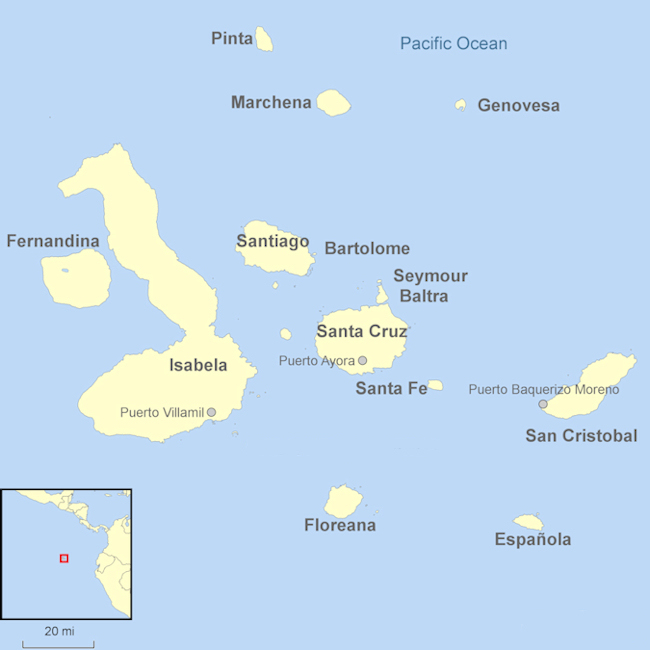
The Galápagos Islands are an archipelago of volcanic islands distributed on either side of the Equator in the Pacific Ocean
surrounding the centre of the Western Hemisphere, 906 km west of continental Ecuador, of which they are a part.
The islands are known for their vast number of endemic species and were studied by Charles Darwin during the Voyage of the
Beagle, as his observations and collections contributed to the inception of Darwin's theory of evolution by natural selection.
The first recorded visit to the islands happened by chance in 1535, when Fray Tomás de Berlanga, the Bishop of Panamá, was
blown off course during a voyage to Peru to arbitrate in a dispute between Francisco Pizarro and Diego de Almagro.
De Berlanga eventually returned to the Spanish Empire and described the conditions of the islands and the animals that inhabited them.
The group of islands was shown and named in Abraham Ortelius's atlas published in 1570. The first crude map of the islands was
made in 1684 by the buccaneer Ambrose Cowley, who named the individual islands after some of his fellow pirates or after
British royalty and noblemen. These names were used in the authoritative navigation charts of the islands prepared during the Beagle
survey under captain Robert Fitzroy, and in Darwin's popular book The Voyage of the Beagle.
The new Republic of Ecuador took the islands from Spanish ownership in 1832, and subsequently gave them official Spanish names.
The older names remained in use in English language publications, including Herman Melville's The Encantadas of 1854.
Isla Santa Cruz
The island of Santa Cruz has the largest and most developed town in the Galápagos; almost every visitor to the islands spends al least some time here, even if it's simply commuting from the airport on nearby Isla Baltra to a cruise ship in the harbor of Puerto Ayora. However, to anyone who stays for longer, the island of Santa Cruz is more than just a way station ar place to feel connected to the modern, world. It's a destination in itself, full of visitors sites, easily accessible beaches, and a base for adventurous activities far from the tourism trail.
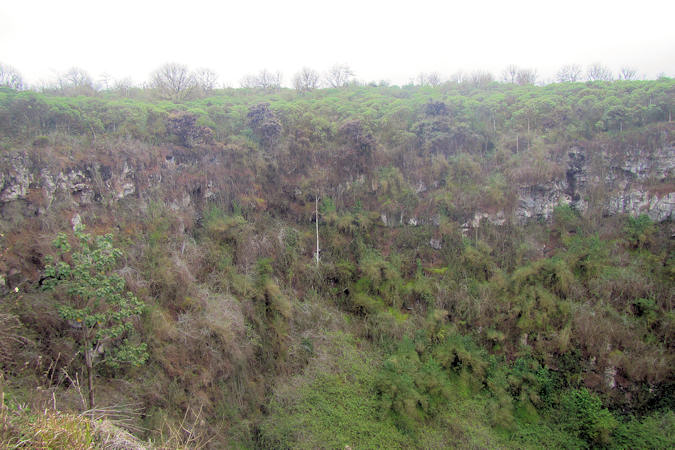 |
|||||
Los Gemelos
These two large pit craters along the road from Puerto Ayora to Baltra were caused by the collapse of empty magma chambers.
A circular trail to the larger crater passes through the beautiful Scalesia forest, which is an excellent place to observe terrestrial birds,
including Galapagos Mockingbird, the Galapagos Dove, and several Finch species.
Rancho El Manzanilo
Santa Cruz also offers excellent opportunities for viewing wild tortoises, both roaming through pastures in the agricultural zone and
in the Tortoise Reserve, which is accessible from Santa Rosa or Salasaca.
Several farms serve food and allow visitors to explore their grounds in search of tortoises.
The pond at El Manzanilo is surrounded by forest where White-cheeked Pintail, Darwin’s finches, Galapagos Flycatcher, Yellow Warblers
can be seen.
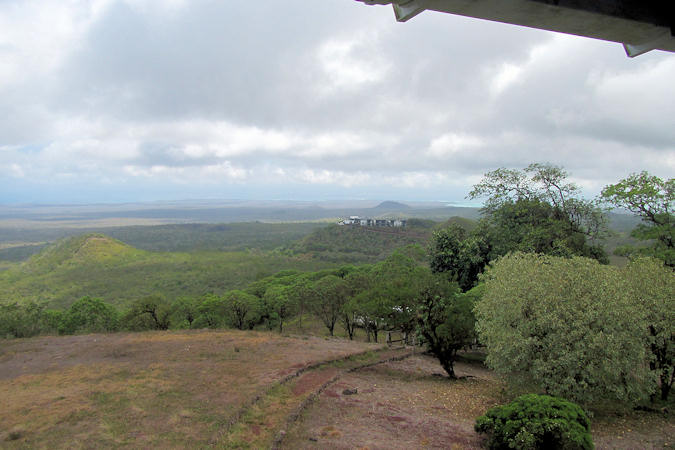 |
|||||
Cerro Mesa
Cerro Mesa is a restoration project started by a local family on land that is habitat to Galapagos Tortoises.
The largest crater on Santa Cruz is located on the property as well as the ‘cerro’ which has an extraordinary viewpoint where
you are rewarded with a 360 degree view of the island of Santa Cruz.
It is an excellent location to observe numerous endemic plants as well as up to 7 species of finch.
Black Turtle Cove
A dinghy ride into Black Turtle Cove, located on the north coast of Santa Cruz, provides a window into a quiet Galapagos hideout.
Sea Turtles feed and mate in the calm waters and three species of sharks are found there – the Black-finned Reef Shark, the White-tipped
Reef Shark, and the Galapagos shark.
Groups of Spotted Rays are also often seen – as are Egrets and Lava Herons.
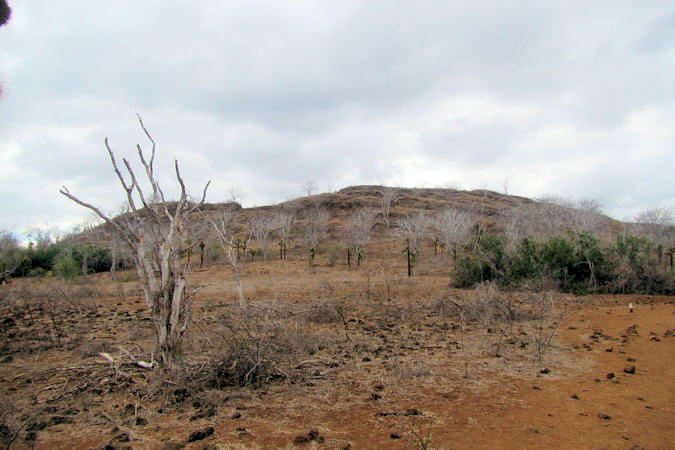 |
|||||
Dragon Hill
Dragon Hill is one of the few visitor sites directly related to a conservation program of the Charles Darwin Foundation and
the Galapagos National Park. In 1975 the population of land iguanas of northeast Santa Cruz, as well as at Cartago Hill on Isabela,
were decimated by feral dogs.
The breeding and rearing program for land iguanas was begun as an emergency response to this devastation.
The program has been very successful and the last land iguana was repatriated to Dragon Hill from the Iguana Center in 1991.
This visitor site was opened in 1993 to provide an additional chance for observing land iguanas.
The trail circles Dragon Hill where you can observe Land Iguanas and their many burrows on the hillside.
The landing site at the rocky shore is a wonderful place for snorkeling.
Puerto Ayora
This town, the largest in terms of population and size in the Galápagos, is a suprise to most visitors, who don't expect to find anything but plants and animamals on the islands.
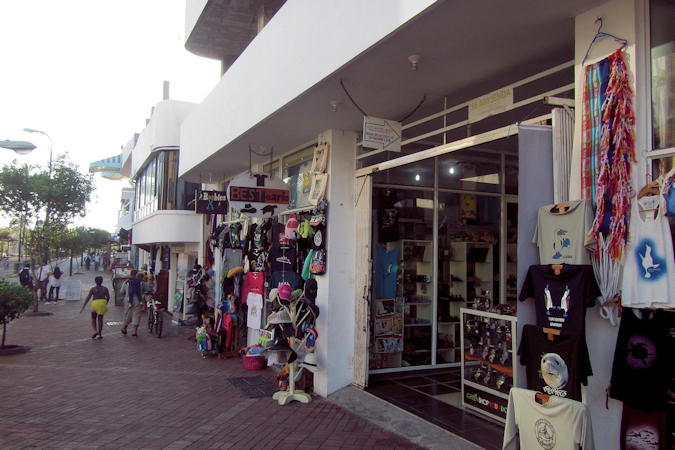 |
|||||
Puerto Ayora looks and feels like a fairly prosperous mainland Ecuadorian coastal town, despite the sea lions and pelicans hanging
around the waterfront.
The Harbour at Academy Bay is bustling with activity, with tourist and inter-island travelers getting on and off small boats and
medium sized cruizers at the dock, and shutttels go back and forth to lareger cruise liners anchored in the bay.
Charles Darwin Research Station
A ten minute walk from the center of town, the Charles Darwin Research Station is the operational center of the international non-profit
Charles Darwin Foundation.
The visitor center contains exhibits dealing with climate and geography and provides insight into the evolution of flora and fauna as
well as current conservation programs.
The Darwin Station conducts research and provides technical assistance to other researchers and governmental agencies, in particular
the Galapagos National Park.
The Darwin Station also provides environmental education to communities and schools in Galapagos.
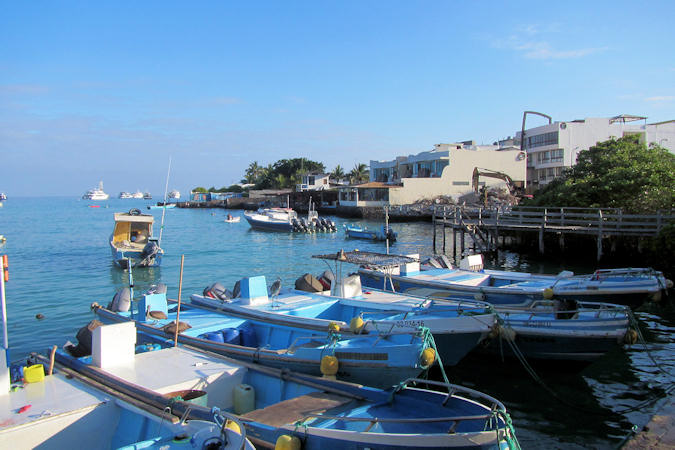 |
|||||
The Fausto Llerena Tortoise Center, a long-term program run jointly by the Galapagos National Park Directorate and the
Charles Darwin Foundation, began in 1965 to save the giant tortoise population on Pinzón.
It was quickly expanded to include other populations, in particular that of Española where only 14 individuals remained.
As of 2008, more than 4.000 young tortoises from eight different populations have been repatriated to their island of origin, with
nearly 1.500 going back to Española.
At the Tortoise Center, visitors can observe a variety of tortoises, including hatchlings, juveniles, and full-grown individuals.
Las Salinas
This is where the local people still harvest seawater to collect the salt, they use it to make the famous galapagos dried fish. It’s
an interesting example of how the locals have managed to source ingredients to make life just a little more enjoyable. The pools are
very other worldly in shades of pale pink water trimmed with white crystals.
Islas Plazas
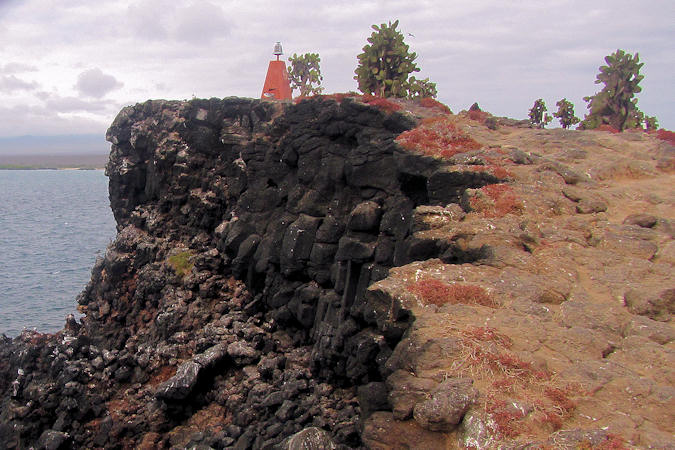 |
|||||
The Plazas Islands are twin islands off the east coast of Santa Cruz. North Plaza is closed to visitors while South Plaza
is one of the highly preferred visitor sites.
Both islands were formed by geological uplift and tilt to the north, with cliffs on their southern coasts. Despite its small size,
South Plaza is home to a large number of species, including a large population of Sea Lions, a healthy population of Land Iguanas – some
of the smallest in the islands, numerous marine iguanas, and cliffs full of nesting seabirds, such as Swallow-tailed Gulls, Red-billed
Tropicbirds, Galapagos Shearwater, Nazca Boobies, and several other species.
Much of the island is covered with Sesuvium, a succulent plant species that is green to yellowish in the wet season and a bright red in
the dry season. The island also has a forest of large, prickly pear cactus, which provides food for the land iguanas.
The circular trail leads up to the 25-m-high cliff on the south side of the island where many seabirds nest.
Isla Seymour
Named after the English nobleman Lord Hugh Seymour, North Seymour was formed by a series of uplifts of submarine lava along with Baltra (also called South Seymour) and the northeastern part of Santa Cruz, resulting in flat plateaus.
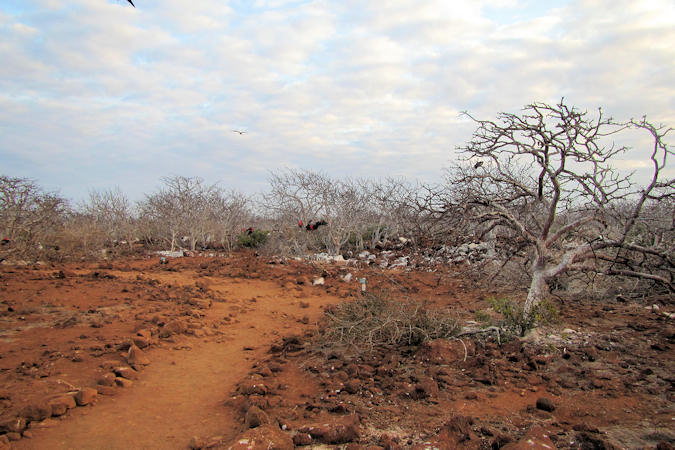 |
|||||
A rocky 2.5 km trail encircles some of the largest, most active seabird-breeding colonies in the islands.
Magnificent Frigatebirds and Blue-footed Boobies are the main attractions and there is always some kind of courtship,
mating, nesting or chick-rearing to observe. You can get close to the nests - there is always at least one pair of silly boobies that
built there nest in the middle of the trail.
Sea Lions and Land and Marine Iguanas are common; occasional Fur Seals, Lava Lizards and Galapágos Snakes are seen, to.
Introduced rats were eradicated from the island as a pilot project prior to the Rat Eradication Campaigns.
on Pinzón and Rábida Islands. However, rats may eventually repopulate North Seymour, swimming from Baltra to Mosquera to North Seymour.
Isla Santa Fé
Santa Fe Island, also called Barrington Island after British Admiral Samuel Barrington, is a small, relatively flat island at
the center of the Archipelago, to the southeast of Santa Cruz Island.
Geologically, it is one of the oldest volcanoes, with rock formations below the surface of the water that date back 3.9 million years.
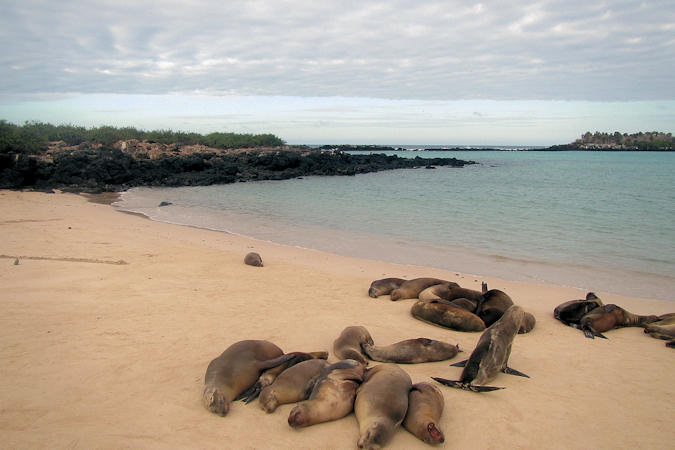 |
|||||
The visit begins with a wet landing on the small beach in Barrington Bay on the northeast side of the island. Large numbers
of Sea Lions are found on the beaches in the bay and can often be seen surfing in the waves.
There are two trails, one short loop that is fairly close to the beach and provides a close-up look at the massive Santa Fe Opuntia
cactus. Santa Fe Land Iguanas as well as Galapagos Hawks are often seen along the visitor trail.
The second trail climbs a steep cliff, providing a view of the inland section of the island.
Santa Fe is home to two species endemic to the island: the Santa Fe Land Iguana (Conolophus pallidus) and the Santa Fe Rice
Rat (Oryzomys bauri). The land iguana population was recently estimated to have 6.500-7.000 individuals.
The snorkeling conditions are excellent
Isla San Cristóbal
San Cristóbal is the fifth largest and easternmost island of the Galapagos. It is comprised of three or four fused volcanoes, all
extinct.
It is home to the oldest permanent settlement of the islands and is the island where Darwin first went ashore in 1835.
The town of Puerto Baquerizo Moreno is the capital of the Galapagos province. It is home to many government offices, an Ecuadorian
Navy facility, and an airport with daily flights to the mainland.
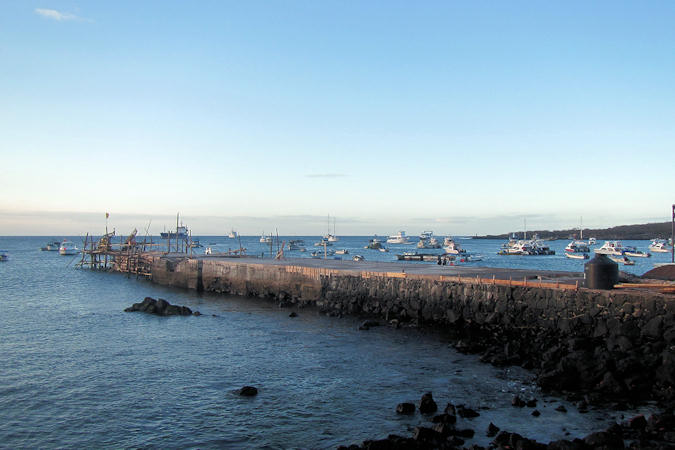 |
|||||
Puerto Baquerizo Moreno
Founded by the colonist General Villamil in the mid-nineteenth century, the town was named after Alfredo Baquerizo Moreno, who in 1916
was the first Ecuadorian president to visit the islands.
It is the second largest community in Galapagos, after Puerto Ayora on Santa Cruz. The majority of the residents of San Cristóbal live
in the port city.
It main streets, the Malecón Charles Darwin, which runs along the waterfront, where visitors can find restaurants, souvenir shops,
and hotels.
Puerto Baquerizo Moreno has also become the focus of the Galapagos’ growing reputation among South Americans as a surfing hotspot.
The waves are best at the beginning of the warm-wet season, when the water is warm enough not to need a wet suit. Tongo Reef, west
of town, is one of the better places to surf.
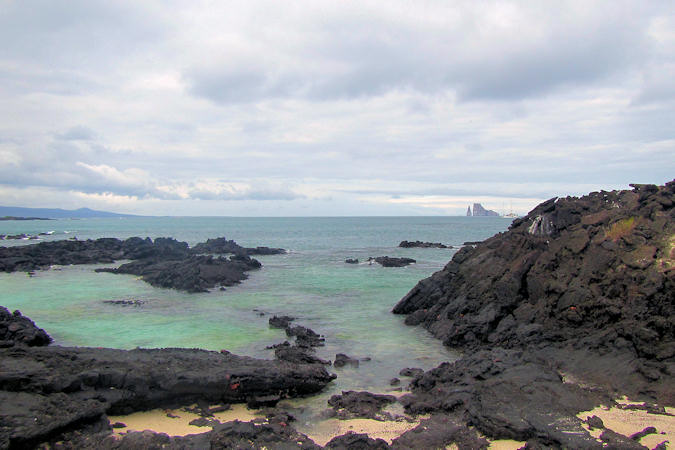 |
|||||
Cerro Brujo
The primary attraction of this site is the coral sand beach. It is an excellent place to swim and snorkel.
Cerro Brujo is the remains of a tuff cone. It is one of the first sites visited by Charles Darwin. Captain Fitzroy climbed
to the top of the hill to scout out reefs.
It has an impressive landscape, where it is often possible to see coastal and migratory birds; Hudsonian Whimbrel, as well as the endemic
San Cristobal Mockingbird.
At times the lagoon is completely dry and deposits of salt may be found in the bottom. The people of Puerto Baquerizo Moreno used to use
the lagoon as a salt mine.